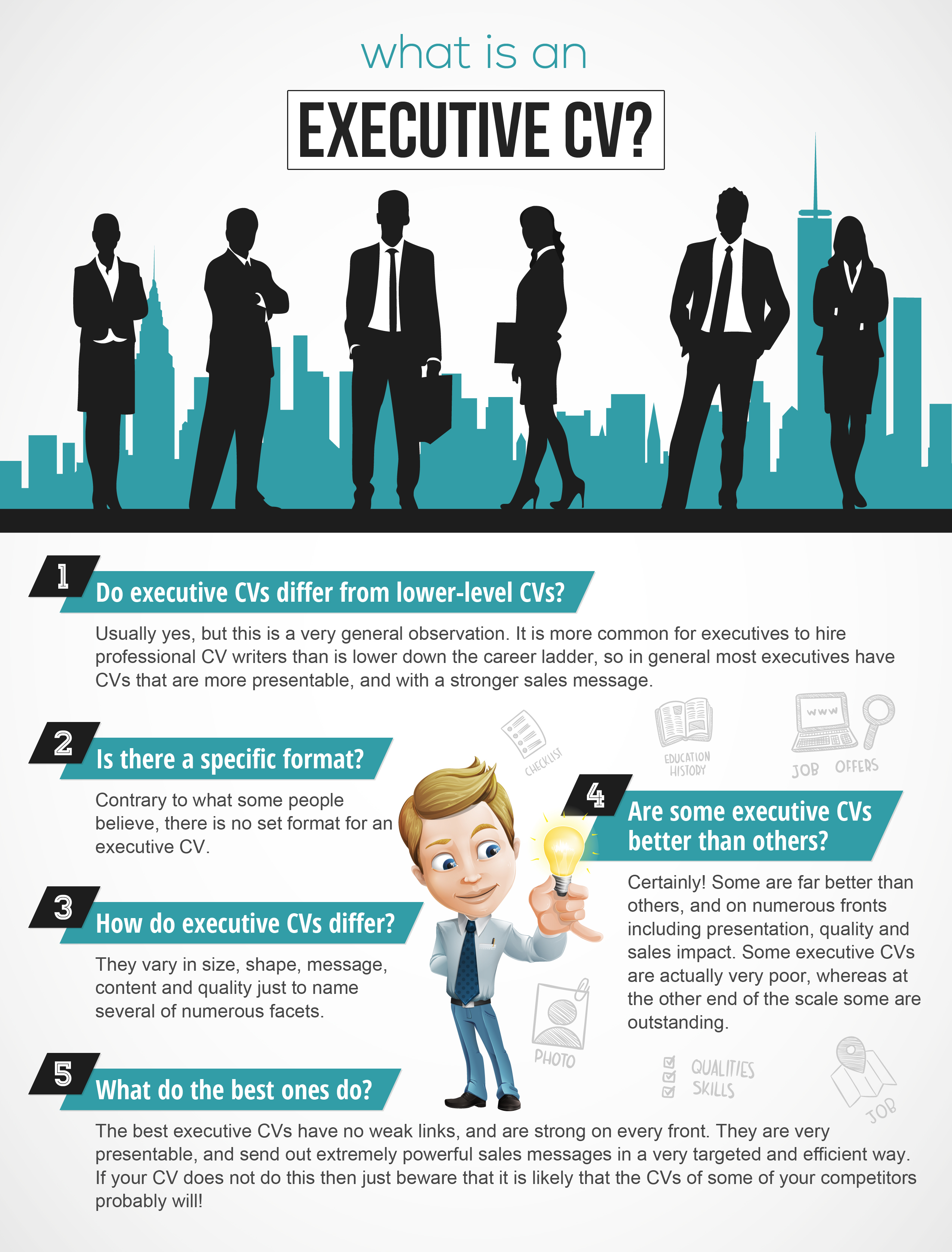What is an executive CV?
Some people and certain lesser recruiters will try and have you believe that an executive CV is some special kind of beast of a curriculum vitae, and if you have an “executive CV”, as opposed to a normal one in your possession it will miraculously propel you up the career ladder quicker than you can say, ‘CEO.’
Jumping on the bandwagon, pound signs glued to eyeballs, there are various individuals and companies offering fast-track tickets to the promised extolled boardroom in the form of the magical ‘executive CV format.’
The only snag with all this is that much of it is claptrap. Indeed, the reality is that there is no de facto executive CV formula, format or standard. On the contrary, one of the main constants with executive CVs is that they vary quite considerably, and come in all shapes, sizes and formats. Moreover, the quality and effectiveness of executive and director level CVs is wide ranging.
Just as is the case further down the career ladder, many executives also struggle to sell themselves on paper, and their CVs range from very basic at one end of the scale to excessively overcomplicated at the other. In between these two extremities are a myriad of other structures, styles and formulas that senior level professionals use with varying degrees of success (or lack of it).
So which one works best?
We are back to the same old $64,000 question. To best answer this let us look at the question from a different angle.
Over the years I have seen thousands of executive CVs. Notably, people send me their CV not because it’s working, but because it isn’t working. Unsurprisingly, each CV that I receive has flaws – usually numerous flaws, and on various fronts. This includes many CVs bought from suppliers under the “executive CV” mythical tag. One common theme revolves around completely changing the presentation from text-centric MS Word documents into image focused PDFs – and some candidates pay hefty sums for the privilege. Even so, as mentioned, people don’t come to me because their CV is working. On the contrary, they come to me specifically because they want me to fix their failing CV. Perhaps understandably, people who pay significant sums for a very presentable image focused “executive CV” tend to be at a loss as to why they keep missing out on good jobs. Each case is different, and varying factors tend to be involved, but in my experience a lot of the time it generally boils down to the CV not selling the candidate powerfully enough. Having a very pretty format is all well and good, but when push comes to shove you still need to sell yourself, and at executive/director level you need to sell yourself more than most. Somewhat paradoxically, some very expensive, very presentable formats are just not conducive to selling the skills of candidates in the optimum. Indeed, many such formats, if anything are counter-productive!
Why is this?
There are numerous reasons for this, but one of the most fundamental reasons boils down to something pretty basic; namely the fact that you only have a very limited amount of space to sell yourself on a CV, and especially if you want to keep it under the recommended two-page maximum. As such, selling space is at premium, and if you eat huge chunks into your all-important selling space just to incorporate graphics, charts or various other gimmicks, then you effectively reduce and limit the amount of space you have to include your all-important achievements. And its achievements that sell you to employers over and above anything else.
When candidates ask me why their CV is not working sometimes they are surprised when I say because it’s not selling you. Some people seem to be under the impression that ‘price tag + looks = success’ when it comes to CVs. However, again that is just mythical claptrap. Just because something looks good and includes flashy modern graphic/icons it doesn’t necessarily mean that it is selling your skills effectively – and unless you sell your skills to the maximum it certainly won’t wash with discerning employers.
Not everyone really understands what I mean about selling themselves powerfully until after I have rewritten their CV. In fact most people don’t. However, in short nothing sells candidates like high impact, powerful achievements. Significantly, while I am a great believer in the adage the best CVs say more but in fewer words, you still need a certain amount of even limited spelling space (both vertical and horizontal) to maximise this sales message. You can’t realistically represent a truly outstanding career in just 10 words, and nor can you do it effectively if the format you use squashes the text together at the expense of images.
At the other extreme some other so-called ‘executive formats’ are extremely wordy/cluttered documents which tend to include pretty much every conceivable skill, trait and attribute known to recruitment. It’s a bit like trying to cover every base, but quite haphazardly and without enough backing to give the document real substance.
The best CVs for executives are not those that make sweeping, wild and unsubstantiated claims, or those with the flashiest icons and the clever graphs. On the contrary, the most successful executive CVs are those which tell very demanding employers the things that they want to hear. And the best way to do this is to present this message clearly, legibly and powerfully.
Not so mythical then, as it happens – although it is still much easier said than done to pull off, and writing a top quality senior level CV is very much a specialist skill – and there is certainly a lot more to it than most people (and certain companies) realise.

Free Resources
Paul’s book

Paul’s groundbreaking curriculum vitae book, ‘The One Page CV’ published by Pearson Education.





